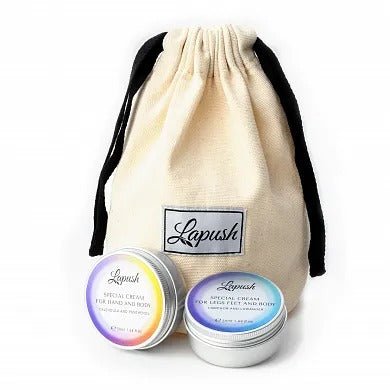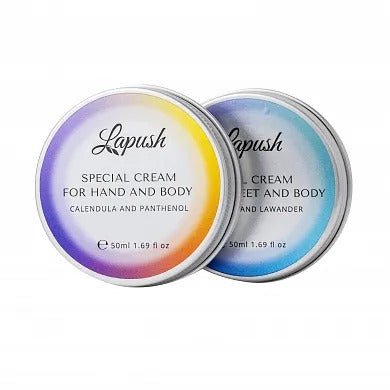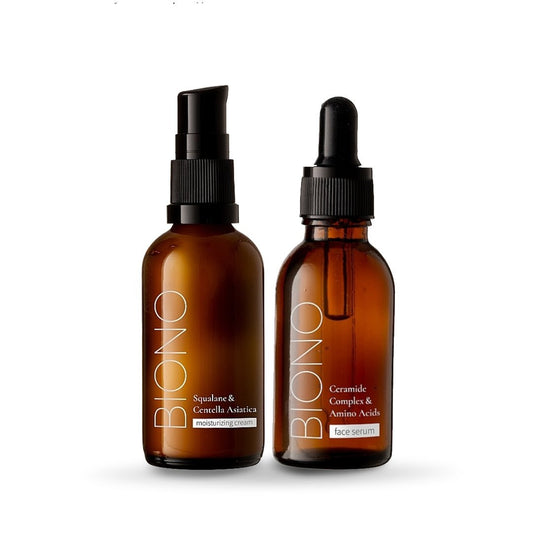
Winter skin care: expert tips and effective cosmetics
The cold months of the year are a real challenge for our skin. Sharp temperature changes, frosty wind, dry air from heating and lack of sunlight make the skin vulnerable, dry and prone to irritation. Proper winter skin care is not just a tribute to fashion, but a real necessity to maintain a healthy and radiant face even on the coldest days.
Why skin needs special care in winter
Winter radically changes the conditions our skin finds itself in. The air temperature can drop below zero, humidity drops to critical levels, and we are constantly moving from frost to warm rooms. All this disrupts the natural hydrolipidic barrier of the epidermis - a protective layer that retains moisture inside the cells.
Dermatological studies show that in winter, transepidermal moisture loss increases by 25-30% compared to the summer months. This means that even oily skin can feel tight and uncomfortable. And for dry and sensitive skin types, winter becomes a period of particular risk - peeling, redness and even microcracks may appear.

Main skin problems in the cold season
Before we talk about winter skin care , it's important to understand what specific problems we face. The most common of these is dryness and dehydration. When skin loses moisture faster than it can replenish it, it becomes rough, dull, and fine lines from dehydration may appear.
The second problem is increased sensitivity. Cold air damages the protective barrier, which makes the skin react more sharply to cosmetics that it previously tolerated well. Redness, burning, and a feeling of tightness appear. This reaction is especially noticeable on the cheeks and around the nose - the most vulnerable areas of the face.
The third problem that is often forgotten is couperose and increased spider veins. Sharp temperature changes cause capillaries to either narrow or expand, which can lead to their persistent expansion. For people prone to couperose, winter is a period when special care and the right winter cosmetics with soothing ingredients are required.
How to change your daily care routine
Your winter skincare routine should be different from your summer routine. The first step is to replace light gel textures with richer ones. If you used a fluid or light cream in the summer, now is the time to switch to a thicker moisturizing or even nourishing cream with occlusive ingredients.
Cleansing also needs correction. Hot showers and active foams for washing become enemies. The optimal water temperature is barely warm, and the cleanser should be mild, with a pH close to the skin. Hydrophilic oil or milk for washing is an ideal choice for the winter period, as they cleanse without disturbing the lipid barrier.
The frequency of exfoliation should also be reduced. If you exfoliated twice a week in the summer, once a week is enough in the winter, and it is better to choose enzyme or mild acid peels instead of abrasive scrubs. Aggressive exfoliation increases dryness and can lead to microtraumas, which will cause the skin to lose even more moisture.
Key ingredients in cosmetics for cold pores
Proper winter skin care is impossible without understanding which active ingredients really work. First and foremost is hyaluronic acid, a moisture magnet molecule. It retains water in the cells, providing long-lasting hydration. Important: hyaluronic acid works optimally with sufficient air humidity, so it is advisable to use a humidifier in heated rooms.
Ceramides are lipids that are a natural part of the skin's protective barrier. Cosmetics with ceramides literally "patch" the damaged barrier, preventing moisture loss. Formulas that combine ceramides, cholesterol, and fatty acids in a ratio close to natural are especially effective.
Occlusive ingredients create a thin film on the skin's surface that physically prevents moisture from evaporating. These include:
- Squalane is a light oil identical to natural skin sebum.
- Shea butter — rich in fatty acids, nourishes and protects
- Vaseline is the most effective occlusive, suitable for very dry areas
- Dimethicone is a silicone that creates a "breathable" protective film

Step-by-step winter facial care plan
Effective winter skin care should be consistent and regular. The morning routine begins with a gentle cleansing - micellar water or foam is enough for sensitive skin. Hot water in the morning is taboo, as it washes away the protective lipids produced by the skin overnight.
The second step is a toner or essence with moisturizing ingredients. They prepare the skin for the next steps of care and help the active ingredients from the cream penetrate deeper. Apply the toner to damp skin with patting movements - this is how it works most effectively.
The third step is a serum with concentrated active ingredients. In winter, the best choice is serums with hyaluronic acid, niacinamide, or peptides. After the serum, a cream must be applied - thicker than the summer version. And the final touch is SPF. Yes, even in winter, the sun is active, especially when it reflects off the snow, so protection from ultraviolet rays is necessary.
Special care for different skin types
Oily skin can behave unpredictably in winter. On the one hand, sebum production decreases due to the cold, on the other hand, due to overdrying, it can start to produce even more oil to compensate. The solution is light gel moisturizers with hyaluronic acid, but without heavy oils, plus regular but gentle cleansing.
Dry skin needs maximum nourishment and protection. Rich creams with argan oil, shea butter, squalane are appropriate here. Don't be afraid of multi-layered care: essence + serum + cream + protective oil on top. At night, you can use a sleeping mask — an intensively restorative product that works while you sleep.
Combination skin requires a zoned approach. The T-zone can remain oilier, so apply a lighter moisturizer there, and a thicker cream on the cheeks and around the eyes. Multi-masking (different masks for different areas of the face) is a great technique for combination skin in the winter. This helps balance the needs of different areas of the face.
Hydrating the skin from within: water and nutrition
External care is only half the battle. Winter skin care must include internal hydration. Paradoxically, in winter we often drink less water than in summer, although our skin needs it no less. The norm is at least 1.5-2 liters of clean water per day, at warm or room temperature.
Nutrition directly affects the condition of the skin. In winter, it is important to get enough Omega-3 fatty acids - they strengthen the protective barrier from the inside. Fatty fish, nuts, flax seeds, avocados - your allies in the fight for healthy skin. Antioxidants from berries, vegetables and green tea protect cells from oxidative stress.
Vitamins are also critically important. Vitamin D deficiency is almost inevitable in winter due to the lack of sun, and it affects skin regeneration. Vitamin E protects the lipid barrier, vitamin C stimulates collagen production. If the diet is not balanced enough, it is worth considering high-quality dietary supplements, but only after consulting a doctor.
Mistakes to avoid in winter
The first common mistake is using too hot water for washing and showering. It seems that warmth is nice and right in the cold, but high temperatures destroy the lipid barrier faster than anything else. After a hot shower, the skin may feel very tight - this is a signal that the protective layer is damaged.
The second mistake is not using sunscreen. "You can't tan in winter" is a typical misconception. UV rays penetrate clouds and reflect off snow, increasing their effects. Without SPF, the skin ages faster and age spots become more pronounced. Even on cloudy winter days, a cream with SPF 30 protection is a must.
The third mistake is aggressive exfoliation. Trying to "sand off" peeling leads to the opposite result. Mechanical scrubs with large particles injure weakened skin, and frequent acid peels make it even more sensitive. Optimally, once a week, a mild enzyme peel or a peeling glove is used. This will help renew the skin without aggression.

Special care for lips and hands
The skin of the lips lacks sebaceous glands, so it is the first to become dehydrated. Licking your lips in the cold is the worst habit, because saliva dries out the delicate skin even more. The right approach is a thick balm with Vaseline, shea butter or lanolin. Apply it every 2-3 hours and always before going outside.
The following scheme works for intensive restoration of chapped lips:
- In the evening, apply a thick layer of honey to your lips (if you are not allergic) for 10 minutes.
- Gently massage your lips with a soft toothbrush to remove flaking.
- Rinse the honey off with warm water and apply a thick balm or even pure cocoa butter.
- Repeat the procedure 2-3 times a week until complete recovery.
Hands suffer from the cold no less than the face. Frequent washing, disinfectants, frosty air - all this leads to dryness, cracks and premature aging of the skin of the hands. Hand cream should become your constant companion in your pocket, bag, on your desk. Apply it after each hand washing and before going to bed, use an intensive mask - a thick cream under cotton gloves for the whole night.
How to save the result: additional recommendations
A humidifier is not just a gadget, but a real investment in skin health. Heating devices reduce indoor humidity to 20-30%, while the comfortable level for the skin is 40-60%. A working humidifier helps winter cosmetics work more effectively and reduces transepidermal moisture loss.
Protection from wind and frost is a practical necessity. Apply a thick protective cream 20-30 minutes before going outside. This will give it time to absorb and create a barrier. A scarf covering the lower part of the face, gloves, and a hood are not just fashion items, but also protect the skin from aggressive environments.
Regularity is the main secret of success. Winter skin care cannot be skipped. If you are very tired in the evening, the minimum is cleansing and a thick cream. Skipping care means that the skin will be unprotected all night, and the morning will begin with even greater dryness. Make your winter routine a habit, and in a week you will see the first results - softness, comfort, healthy appearance.
In summary: healthy skin all winter long
Winter skin care is a comprehensive approach that combines the right cosmetics, a healthy lifestyle and protection from external factors. By investing time in your daily routine now, you prevent serious problems that can arise due to dryness and damage to the protective barrier. The main thing is to listen to your skin and adapt your care to its needs.
Don't be afraid to experiment with textures and find the products that work for you. The right cosmetics for winter, regularity and patience are the three keys to success. And remember: healthy, radiant skin is possible not only in summer, but also in the midst of the most severe frosts. It will gratefully respond to care with beauty and comfort throughout the cold season.













